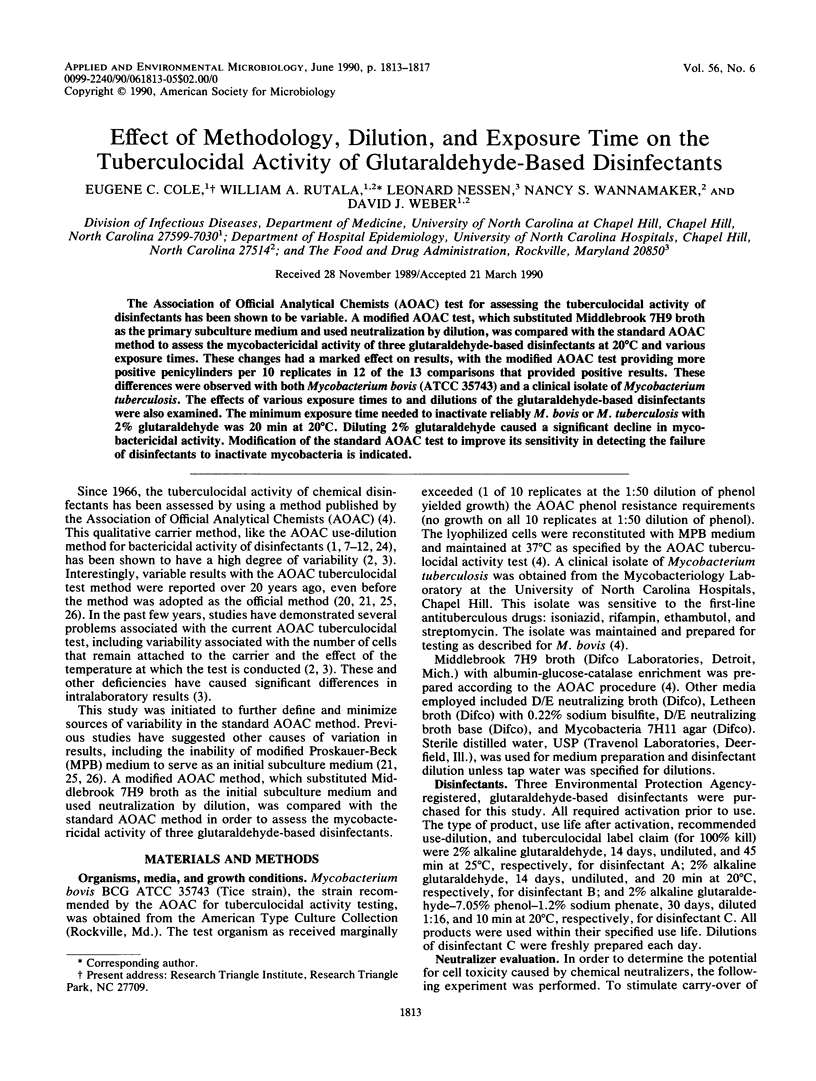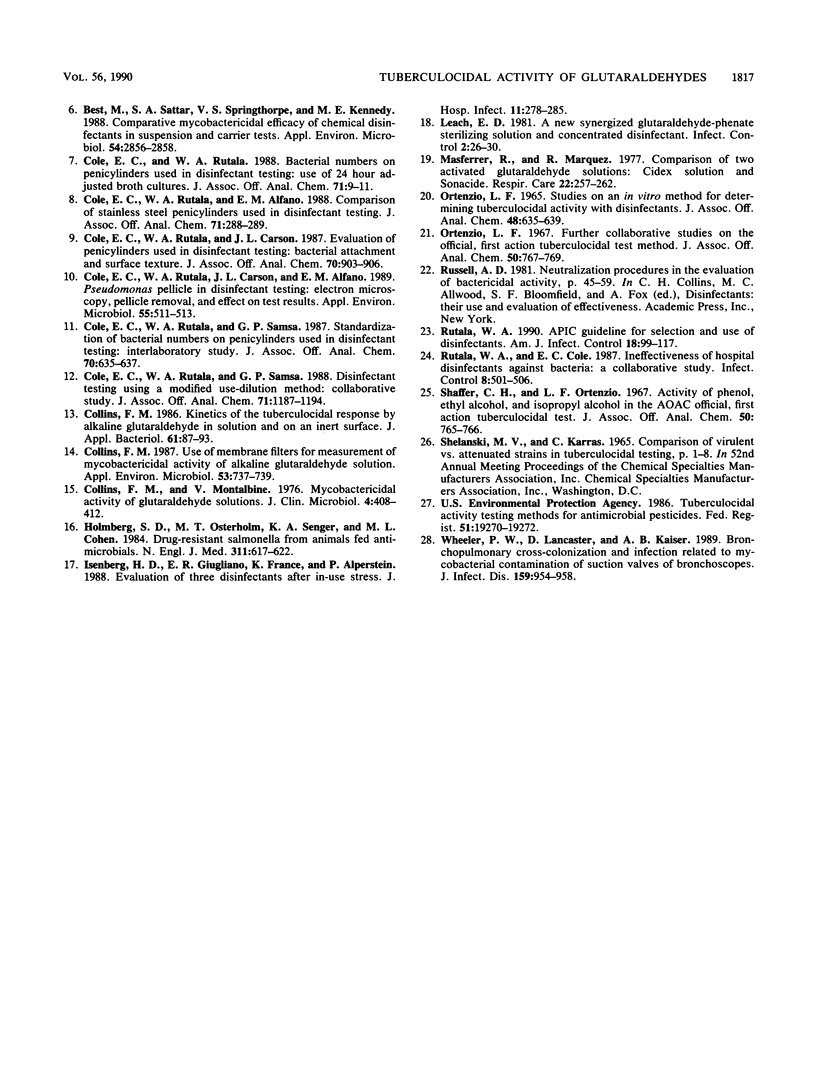Abstract
The Association of Official Analytical Chemists (AOAC) test for assessing the tuberculocidal activity of disinfectants has been shown to be variable. A modified AOAC test, which substituted Middlebrook 7H9 broth as the primary subculture medium and used neutralization by dilution, was compared with the standard AOAC method to assess the mycobactericidal activity of three glutaraldehyde-based disinfectants at 20 degrees C and various exposure times. These changes had a marked effect on results, with the modified AOAC test providing more positive penicylinders per 10 replicates in 12 of the 13 comparisons that provided positive results. These differences were observed with both Mycobacterium bovis (ATCC 35743) and a clinical isolate of Mycobacterium tuberculosis. The effects of various exposure times to and dilutions of the glutaraldehyde-based disinfectants were also examined. The minimum exposure time needed to inactivate reliably M. bovis or M. tuberculosis with 2% glutaraldehyde was 20 min at 20 degrees C. Diluting 2% glutaraldehyde caused a significant decline in mycobactericidal activity. Modification of the standard AOAC test to improve its sensitivity in detecting the failure of disinfectants to inactivate mycobacteria is indicated.
Full text
PDF




Selected References
These references are in PubMed. This may not be the complete list of references from this article.
- Alfano E. M., Cole E. C., Rutala W. A. Quantitative evaluation of bacteria washed from stainless steel penicylinders during AOAC use-dilution method. J Assoc Off Anal Chem. 1988 Sep-Oct;71(5):868–871. [PubMed] [Google Scholar]
- Ascenzi J. M., Ezzell R. J., Wendt T. M. A more accurate method for measurement of tuberculocidal activity of disinfectants. Appl Environ Microbiol. 1987 Sep;53(9):2189–2192. doi: 10.1128/aem.53.9.2189-2192.1987. [DOI] [PMC free article] [PubMed] [Google Scholar]
- Ascenzi J. M., Ezzell R. J., Wendt T. M. Evaluation of carriers used in the test methods of the Association of Official Analytical Chemists. Appl Environ Microbiol. 1986 Jan;51(1):91–94. doi: 10.1128/aem.51.1.91-94.1986. [DOI] [PMC free article] [PubMed] [Google Scholar]
- Best M., Sattar S. A., Springthorpe V. S., Kennedy M. E. Comparative mycobactericidal efficacy of chemical disinfectants in suspension and carrier tests. Appl Environ Microbiol. 1988 Nov;54(11):2856–2858. doi: 10.1128/aem.54.11.2856-2858.1988. [DOI] [PMC free article] [PubMed] [Google Scholar]
- Cole E. C., Rutala W. A., Alfano E. M. Comparison of stainless steel penicylinders used in disinfectant testing. J Assoc Off Anal Chem. 1988 Mar-Apr;71(2):288–289. [PubMed] [Google Scholar]
- Cole E. C., Rutala W. A. Bacterial numbers on penicylinders used in disinfectant testing: use of 24 hour adjusted broth cultures. J Assoc Off Anal Chem. 1988 Jan-Feb;71(1):9–11. [PubMed] [Google Scholar]
- Cole E. C., Rutala W. A., Carson J. L., Alfano E. M. Pseudomonas pellicle in disinfectant testing: electron microscopy, pellicle removal, and effect on test results. Appl Environ Microbiol. 1989 Feb;55(2):511–513. doi: 10.1128/aem.55.2.511-513.1989. [DOI] [PMC free article] [PubMed] [Google Scholar]
- Cole E. C., Rutala W. A., Carson J. L. Evaluation of penicylinders used in disinfectant testing: bacterial attachment and surface texture. J Assoc Off Anal Chem. 1987 Sep-Oct;70(5):903–906. [PubMed] [Google Scholar]
- Cole E. C., Rutala W. A., Samsa G. P. Disinfectant testing using a modified use-dilution method: collaborative study. J Assoc Off Anal Chem. 1988 Nov-Dec;71(6):1187–1194. [PubMed] [Google Scholar]
- Cole E. C., Rutala W. A., Samsa G. P. Standardization of bacterial numbers of penicylinders used in disinfectant testing: interlaboratory study. J Assoc Off Anal Chem. 1987 Jul-Aug;70(4):635–637. [PubMed] [Google Scholar]
- Collins F. M. Kinetics of the tuberculocidal response by alkaline glutaraldehyde in solution and on an inert surface. J Appl Bacteriol. 1986 Jul;61(1):87–93. doi: 10.1111/j.1365-2672.1986.tb03762.x. [DOI] [PubMed] [Google Scholar]
- Collins F. M., Montalbine V. Mycobactericidal activity of glutaraldehyde solutions. J Clin Microbiol. 1976 Nov;4(5):408–412. doi: 10.1128/jcm.4.5.408-412.1976. [DOI] [PMC free article] [PubMed] [Google Scholar]
- Collins F. M. Use of membrane filters for measurement of mycobactericidal activity of alkaline glutaraldehyde solution. Appl Environ Microbiol. 1987 Apr;53(4):737–739. doi: 10.1128/aem.53.4.737-739.1987. [DOI] [PMC free article] [PubMed] [Google Scholar]
- Holmberg S. D., Osterholm M. T., Senger K. A., Cohen M. L. Drug-resistant Salmonella from animals fed antimicrobials. N Engl J Med. 1984 Sep 6;311(10):617–622. doi: 10.1056/NEJM198409063111001. [DOI] [PubMed] [Google Scholar]
- Isenberg H. D., Giugliano E. R., France K., Alperstein P. Evaluation of three disinfectants after in-use stress. J Hosp Infect. 1988 Apr;11(3):278–285. doi: 10.1016/0195-6701(88)90106-5. [DOI] [PubMed] [Google Scholar]
- Leach E. D. A new synergized glutaraldehyde-phenate sterilizing solution and concentrated disinfectant. Infect Control. 1981 Jan-Feb;2(1):26–30. doi: 10.1017/s0195941700053704. [DOI] [PubMed] [Google Scholar]
- Rutala W. A. APIC guideline for selection and use of disinfectants. Am J Infect Control. 1990 Apr;18(2):99–117. doi: 10.1016/0196-6553(90)90089-b. [DOI] [PubMed] [Google Scholar]
- Rutala W. A., Cole E. C. Ineffectiveness of hospital disinfectants against bacteria: a collaborative study. Infect Control. 1987 Dec;8(12):501–506. doi: 10.1017/s0195941700067564. [DOI] [PubMed] [Google Scholar]
- Wheeler P. W., Lancaster D., Kaiser A. B. Bronchopulmonary cross-colonization and infection related to mycobacterial contamination of suction valves of bronchoscopes. J Infect Dis. 1989 May;159(5):954–958. doi: 10.1093/infdis/159.5.954. [DOI] [PubMed] [Google Scholar]


